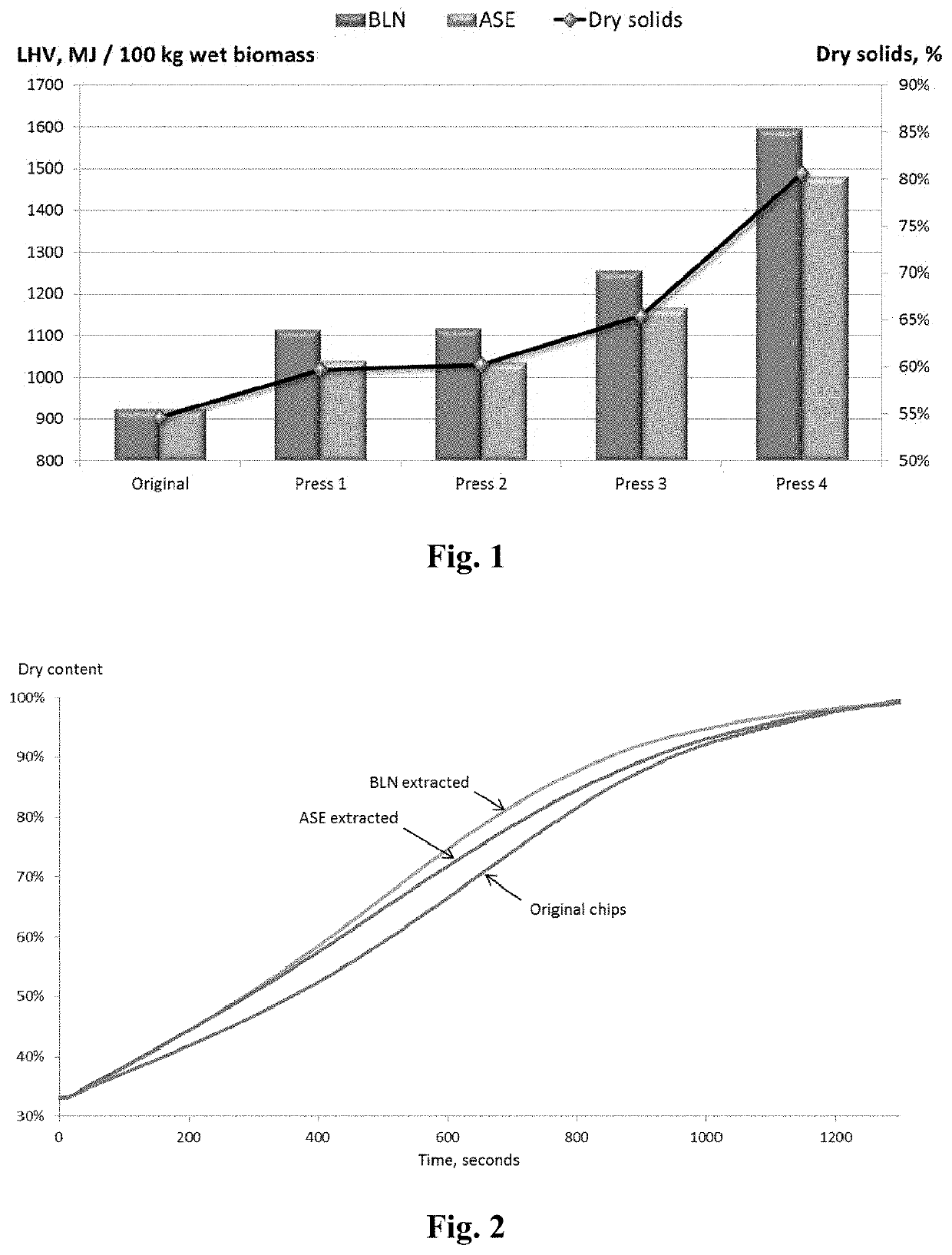Method of converting biomass
a technology of biomass and conversion method, which is applied in the direction of lignin derivatives, separation processes, pretreatment with water/steam, etc., can solve the problems of difficult dewatering of fresh wood chips, inability to use fresh biomass, and inability to increase the rate of water removal, etc., to achieve the effect of reducing the content of hemicellulose in the biomass, and improving the drying efficiency of the biomass
- Summary
- Abstract
- Description
- Claims
- Application Information
AI Technical Summary
Benefits of technology
Problems solved by technology
Method used
Image
Examples
example 1
[0055]Hemicellulose was extracted from the pine (Pinus sylvestris) chips using two methods: the so-called BLN-technology (WO2014009604) and a more traditional batch extraction using an Accelerated Solvent Extractor (Dionex ASE 200) operated at a temperature of 170° C. for 60 minutes. The composition of the original biomass was: water 46%, cellulose 23%, lignin 16% and hemicellulose 15%.
[0056]After the extractions the biomass was drained from free water and dissolved hemicelluloses. The BLN extract contained 1% and the ASE extract contained 11% of the lignin in the original biomass. The remaining biomass after the BLN extraction and drainage of the extract had the following composition: water 75%, cellulose 13%, lignin 9% and hemicellulose 3%. Correspondingly, after the ASE extraction the composition was: water 75%, cellulose 14%, lignin 8% and hemicellulose 3%.
[0057]The drained and warm (ca. 60° C.) biomass was then press-dried using a screw-press with four different pressure settin...
example 2
[0060]In order to evaluate the effect of hemicellulose removal technique on air-drying of wood chips, the original and the un-pressed hemicellulose extracted chips from example 1 were air-dried on an infra-red scale. Before drying all the chips were soaked in 40° C. water for 15 min followed by centrifugation. The resulting dry content of the chips were 33% in all three cases. FIG. 2 shows the drying speed of the three samples. The results show that hemicellulose extracted chips are air-dried approximately 10%-20% faster than un-extracted chips. Hemicelluloses are hygroscopic polymers which retain water, after hemicellulose extraction the pore structure is more beneficial for air-drying. It was also surprising that the effect of extraction technique had such a large effect. The ASE extracted is extracted at 170° C. whereas the BLN extraction is done at 150° C. The increased solubility of lignin at higher temperatures during the ASE extraction most likely clogs the pores of the fiber...
example 3
[0061]In this example, the effect of lignin precipitation on the LHV of wood chips were investigated. Fresh birch wood chips were extracted in a continuous down-flow reactor. A schematic of the reactor is shown in FIG. 3. Reference numeral 1 refers to the reactor.
[0062]The upper section 2 of the reactor 1 was kept between 150° C. and 170° C. with a residence time of approximately 60 minutes and constant circulation of the extract from the lower part 3 to the upper part 4 of the upper section 2 of the reactor. In the lower section 5 of the reactor the extract was cooled down to 60° C.
[0063]The lower section 5 of the reactor 1 had two circulation loops 6, 7 equipped with heat exchangers 8, 9.
[0064]Depending on the applied heat in the upper section various amounts of lignin is dissolved into the hemicellulose extract. Lignin can be deposited back onto the wood chips by lowering the temperature of the hemicellulose extract inside the reactor.
[0065]With regard to this technology referenc...
PUM
| Property | Measurement | Unit |
|---|---|---|
| temperature | aaaaa | aaaaa |
| surface temperature | aaaaa | aaaaa |
| surface temperature | aaaaa | aaaaa |
Abstract
Description
Claims
Application Information
 Login to View More
Login to View More - R&D
- Intellectual Property
- Life Sciences
- Materials
- Tech Scout
- Unparalleled Data Quality
- Higher Quality Content
- 60% Fewer Hallucinations
Browse by: Latest US Patents, China's latest patents, Technical Efficacy Thesaurus, Application Domain, Technology Topic, Popular Technical Reports.
© 2025 PatSnap. All rights reserved.Legal|Privacy policy|Modern Slavery Act Transparency Statement|Sitemap|About US| Contact US: help@patsnap.com


